Discover the Largest Mud Snake Ever Recorded
#mobileSnakeQuizControls { overflow: hidden; text-overflow: ellipsis; white-space: nowrap; }
@media (min-width: 481px) {
.mobile-top-content {
display: none;
}
}
#mobileTopContentCTACarouselControls { overflow: hidden; text-overflow: ellipsis; white-space: nowrap; }
.mobile-top-content .more { color: #fff; }
.mobile-top-content a { color: #fff; text-decoration: underline; }
.mobile-top-content a:hover { color: #fff; text-decoration: underline; }
@media (max-width: 480px) {
.mobile-top-content {
background-color: #06a10b;
color: #fff;
text-align: center;
/*height: 60px;
padding-top:5px;*/
font-size:80%;
/* display: block; */
margin: 0px -30px;
}
}
The Mud Snake is a boldly colored nonvenomous snake endemic to the southeastern United States. These eye-catching snakes are secretive and rarely seen, digging deep burrows through the mud in swampy areas. Their black, glossy backs allow them to blend into their dark, muddy surroundings, while their brilliant red bellies offer a striking contrast of color. These snakes are typically between 4-6 feet in length, but there have been many that are much longer. But just how long is the largest mud snake ever recorded?
What Does the Mud Snake Look Like?
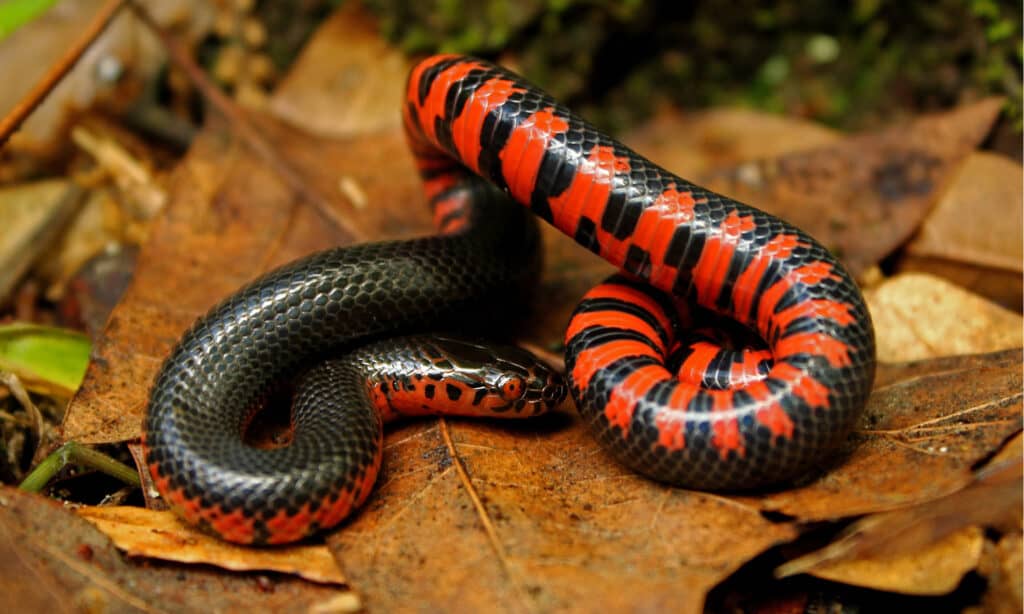
Thesigner_2696/Shutterstock.com
There are two subspecies of mud snakes: the eastern mud snake and the western mud snake. Both subspecies look extremely similar, the biggest different between the two is primarily where each snake is found. The western mud snake, for example, is more common along the coasts of the Gulf of Mexico and up through Illinois.
button.pulse {
transform: scale(1); animation: pulse 2s infinite;
box-shadow: 0 0 0 0 rgba(11, 247, 25, 1);
}
@keyframes pulse {
0% { transform: scale(0.90); box-shadow: 0 0 0 0 rgba(11, 247, 25, 0.5); }
60% { transform: scale(1); box-shadow: 0 0 0 15px rgba(11, 247, 25, 0); }
100% { transform: scale(0.90); box-shadow: 0 0 0 0 rgba(11, 247, 25, 0); }
}
Mud snakes are generally between 40-54 inches in length with thick, cylindrically shaped bodies. The dorsal scales (the scales on the top half of the snake) are glossy, black, and extremely smooth. In the right light, these snakes can even look like they have a metallic or iridescent blue sheen. The belly of the mud snake is a sharp contrast to its back, with bright red and black alternating scales that form an asymmetrically checkered pattern. The red bars along the snake’s belly also extends upwards somewhat along its sides. These snakes are also called “Red-Bellied Mudsnakes” because of the bright red colors on their bellies.
The scientific name of the mud snake is Farancia abacura. “Abacura” comes from the Latin term “abacus,” referring to a mathematical device that has colored beads that move parallel to one another. The patterns of the mud snake’s belly look very similar to an abacus. Additionally, mud snakes also have very small, round black eyes with red irises. On occasion, mud snakes be “anerythristic”, which means that there is white in place of the typical red coloring. Mud snakes have a thick neck matching their thick bodies, with yellow shading along their chins. Their tails are short with a sharp, spine-like scale at the tip that they use for defense. Young mud snakes have much sharper tail points than adult snakes do.
The “Stinging Snake”
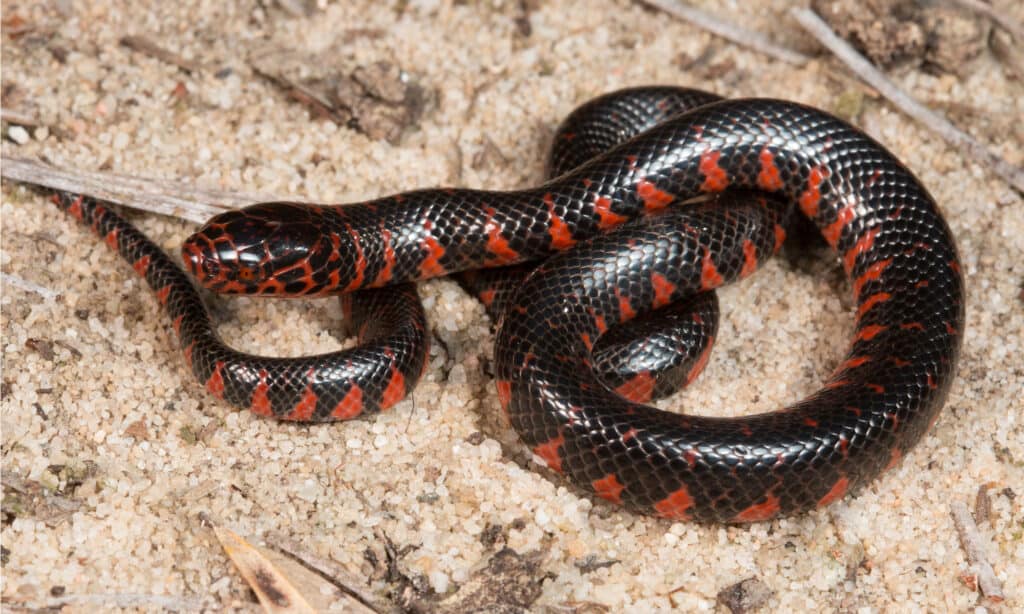
Nathan A Shepard/Shutterstock.com
Mud snakes are nicknamed “stinging snakes” because of their rather unusual tail, which is hard and sharp like a stinger. When threatened, a mud snake will curl up and protect its head while thrusting its sharp tail at the threat and continually poking it. They also are sometimes called “stingarees” and “dart snakes.” Some people even call them “2-step snakes,” believing that a mud snake can “sting” you with venom that kills before you could even take “two steps.”
These names are very misleading, however, as mud snakes do not have stingers, venom, or poison—the worst a mud snake can do is poke repeatedly with its tail. Although they do use their sharp tails as a line of defense, in general mud snakes more commonly use it to help them gain stability in muddy areas, and to hunt slippery animal prey.
The mud snake is also sometimes called the “Hoop Snake” as well, similar to the coachwhip snake. Stories in American Folklore tell of hoop snakes that bite their own tails to form a circle, and then roll after people and try to sting them. Once again, however, this myth is not true.
What is the Largest Mud Snake Ever Recorded?
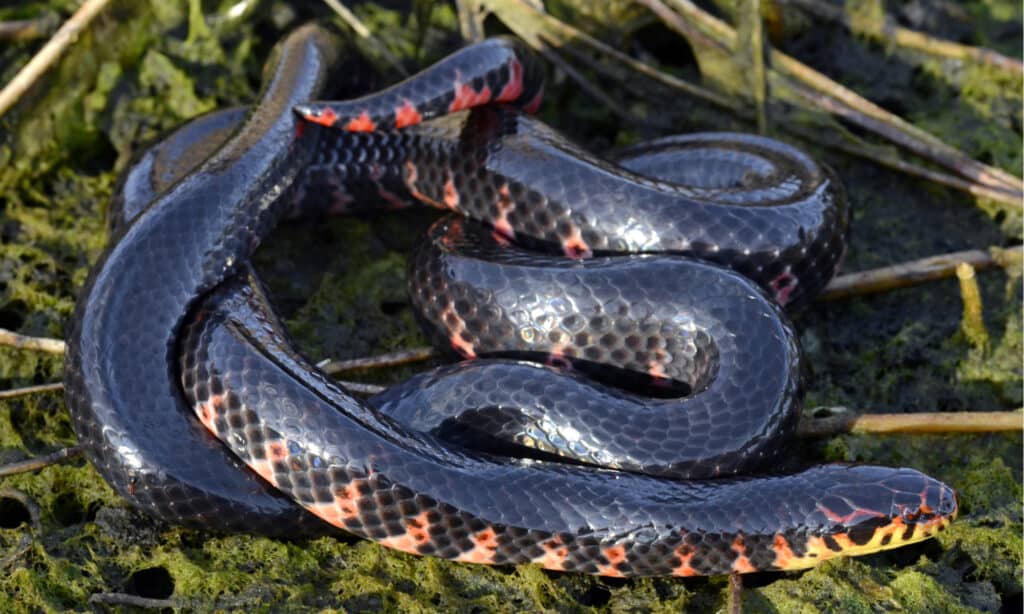
Patrick K. Campbell/Shutterstock.com
Mud snakes have thick, round bodies that typically grow between 30-54 inches in length. However, the largest mud snakes have grown to lengths over 6 feet! The largest Eastern Mud Snake recorded was 81 ½ inches long, and the longest Western Mud Snake recorded was 74 inches long.
Where do Mud Snakes Live?
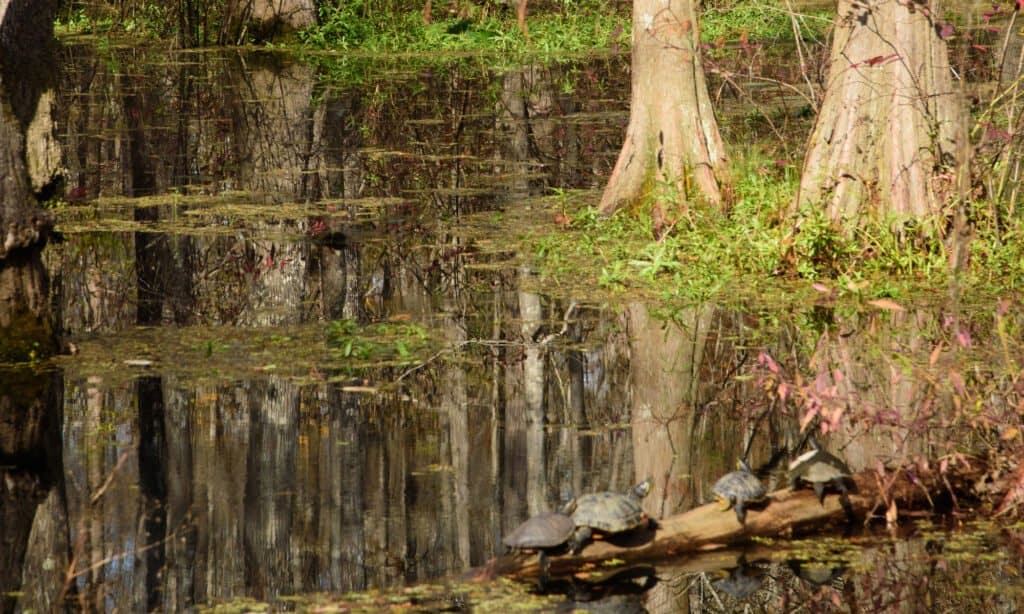
Judy M Darby/Shutterstock.com
Mud snakes are endemic to the southeastern United States. These snakes live in Florida (but not in the Florida Keys), Georgia, South Carolina, North Carolina, Virginia, Mississippi, Alabama, Tennessee, Kentucky, Illinois, Missouri, Arkansas, Louisiana, Texas, and Oklahoma. Mud snakes are semiaquatic and prefer to live where there is plenty of slow-moving water with dense vegetation and debris. They often live in ponds or lakes with muddy bottoms, irrigation ditches, edges of streams, bays, and cypress swamps.
Although mud snakes can technically live on both land and in water, they prefer spending most of their lives in water or buried beneath mud. On land, mud snakes move rather slowly and can act sluggish, whereas in the water they are excellent swimmers and can skillfully dig through deep, thick mud. During rainstorms mud snakes will shelter beneath plants and debris and become much more active right after it rains. It is extremely uncommon to find these snakes during dry weather. Mud snakes much prefer moist weather and being in the water. However, these snakes will travel across dry land and manmade roads to move to a new body of water.
Are Mud Snakes Dangerous?
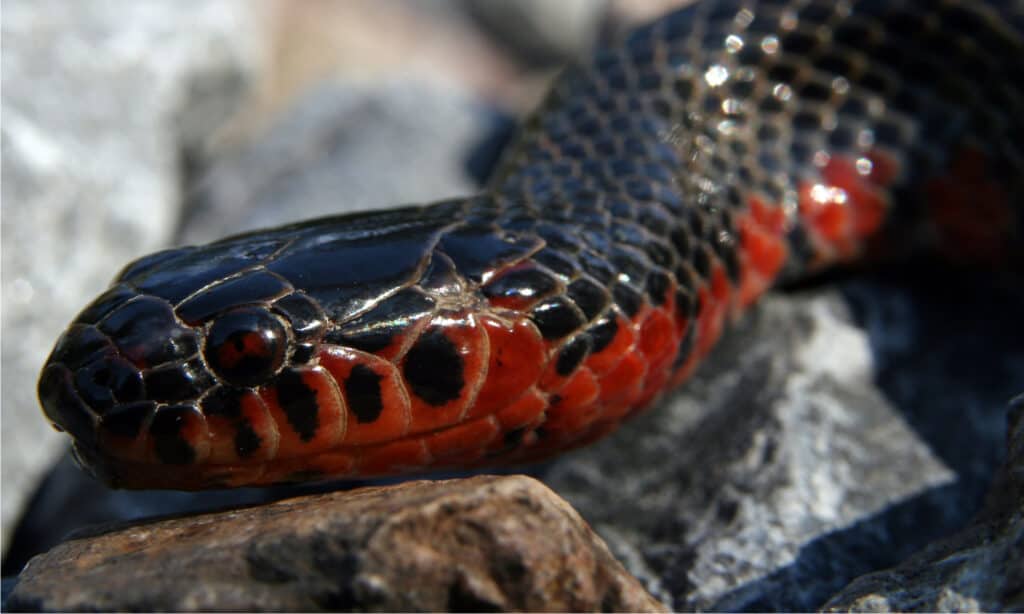
Ryan M. Bolton/Shutterstock.com
Mud snakes are nonvenomous and completely harmless to humans. In fact, mud snakes are extremely calm and docile, and they do not bite. When picked up, a mud snake may attempt to poke you with its sharp tail. However, more often than not this is not an attack, but rather the snake’s attempt to stabilize and gain purchase now that it is off the ground.
These snakes are nocturnal, shy, and extremely secretive. Even snake experts rarely see mud snakes in the wild. These snakes spend most of their time in the water, buried in the mud and hiding among aquatic plants and debris. They only leave the water to lay eggs, mate, or to travel to a new area.
How do Mud Snakes Defend Themselves?
Mud snakes are nonvenomous and do not have many defenses. When attacked by a predator, a mud snake will coil around its body with its bright red and black belly facing up towards the threat. This defense is to remind the predator of the bright red colors of venomous snakes like the coral snake. Because of this, the predator may leave the snake alone, just to be safe. When birds attack and try to eat mud snakes, the snake will throw the sharp tip of its tail at the bird repeatedly, trying to ward it off.
What Do Mud Snakes Eat?
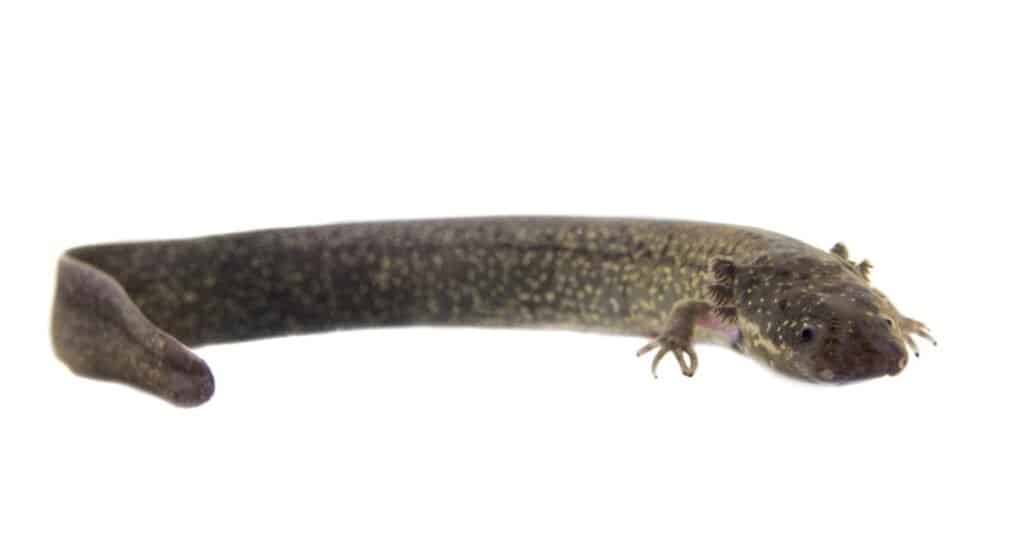
iStock.com/Farinosa
Mud snakes are carnivores but are extremely picky about what they eat. These snakes are amphibian specialists. They particularly specialize in eating giant aquatic salamanders like sirens and amphiumas. Young mud snakes will sometimes eat tadpoles as well. Mud snakes have large rear fangs that help them with capturing and eating slippery salamanders. The snake’s sharply pointed tail also helps it to spike and catch these slimy amphibians. Mud snakes mostly eat greater sirens, three-toed amphiumas, and mole salamanders.
Conservation Status

Jason Patrick Ross/Shutterstock.com
Experts believe that the mud snake is fairly common, although it is rarely seen in the wild and more research is needed to fully understand this unique creature. Because this snake needs wetland habitats and aquatic prey, however, human development and habitat alteration continue to put it at risk. Much of the snake’s wetland habitat is continually being developed and fragmented. Because of this, the mud snake is listed as a “Species of Conservation Concern” in many areas of the southeastern United States.
In addition, since the mud snake is the only animal that specializes in eating amphiuma salamanders, if this snake were to vanish there would not be another animal to step in and fill the empty niche left behind. The loss of the mud snake would disrupt the balance of the ecosystem. In some areas, such as the state of Georgia, mud snakes are further protected by state laws.
Similar Species: The Black Swamp Snake
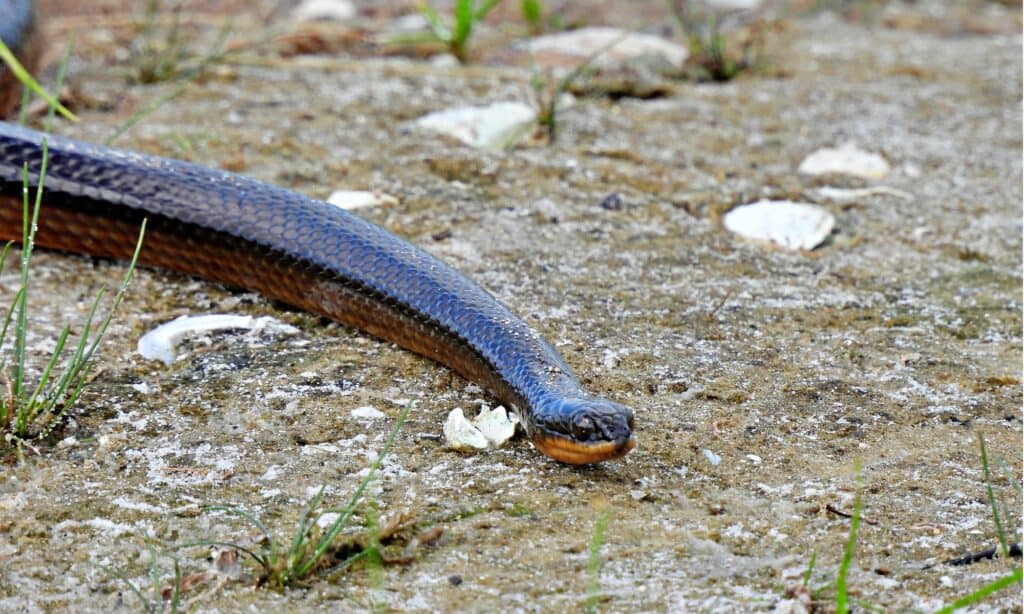
iStock.com/passion4nature
The Black Swamp Snake lives in swampy areas and has a black back and red belly. On top, the black swamp snake looks almost identical to the mud snake. Its belly, however, is a solid bright red color, whereas the mud snake’s belly is patterned with red and black geometric designs. The mud snake also has red bars that come up along the sides of its body. The black swamp snake, on the other hand, is completely black along its sides. In addition, the black swamp snake is smaller and considerably thinner than the mud snake.
Discover the “Monster” Snake 5X Bigger than an Anaconda
Every day A-Z Animals sends out some of the most incredible facts in the world from our free newsletter. Want to discover the 10 most beautiful snakes in the world, a “snake island” where you’re never more than 3 feet from danger, or a “monster” snake 5X larger than an anaconda? Then sign up right now and you’ll start receiving our daily newsletter absolutely free.
More from A-Z Animals
.more-snake-card-image { max-height:140px !important; }
#mobileSnakeQuizControls { overflow: hidden; text-overflow: ellipsis; white-space: nowrap; }
@media (min-width: 481px) {
.mobile-top-content {
display: none;
}
}
#mobileTopContentCTACarouselControls { overflow: hidden; text-overflow: ellipsis; white-space: nowrap; }
.mobile-top-content .more { color: #fff; }
.mobile-top-content a { color: #fff; text-decoration: underline; }
.mobile-top-content a:hover { color: #fff; text-decoration: underline; }
@media (max-width: 480px) {
.mobile-top-content {
background-color: #06a10b;
color: #fff;
text-align: center;
/*height: 60px;
padding-top:5px;*/
font-size:80%;
/* display: block; */
margin: 0px -30px;
}
}
The Mud Snake is a boldly colored nonvenomous snake endemic to the southeastern United States. These eye-catching snakes are secretive and rarely seen, digging deep burrows through the mud in swampy areas. Their black, glossy backs allow them to blend into their dark, muddy surroundings, while their brilliant red bellies offer a striking contrast of color. These snakes are typically between 4-6 feet in length, but there have been many that are much longer. But just how long is the largest mud snake ever recorded?
What Does the Mud Snake Look Like?

Thesigner_2696/Shutterstock.com
There are two subspecies of mud snakes: the eastern mud snake and the western mud snake. Both subspecies look extremely similar, the biggest different between the two is primarily where each snake is found. The western mud snake, for example, is more common along the coasts of the Gulf of Mexico and up through Illinois.
button.pulse {
transform: scale(1); animation: pulse 2s infinite;
box-shadow: 0 0 0 0 rgba(11, 247, 25, 1);
}
@keyframes pulse {
0% { transform: scale(0.90); box-shadow: 0 0 0 0 rgba(11, 247, 25, 0.5); }
60% { transform: scale(1); box-shadow: 0 0 0 15px rgba(11, 247, 25, 0); }
100% { transform: scale(0.90); box-shadow: 0 0 0 0 rgba(11, 247, 25, 0); }
}
Mud snakes are generally between 40-54 inches in length with thick, cylindrically shaped bodies. The dorsal scales (the scales on the top half of the snake) are glossy, black, and extremely smooth. In the right light, these snakes can even look like they have a metallic or iridescent blue sheen. The belly of the mud snake is a sharp contrast to its back, with bright red and black alternating scales that form an asymmetrically checkered pattern. The red bars along the snake’s belly also extends upwards somewhat along its sides. These snakes are also called “Red-Bellied Mudsnakes” because of the bright red colors on their bellies.
The scientific name of the mud snake is Farancia abacura. “Abacura” comes from the Latin term “abacus,” referring to a mathematical device that has colored beads that move parallel to one another. The patterns of the mud snake’s belly look very similar to an abacus. Additionally, mud snakes also have very small, round black eyes with red irises. On occasion, mud snakes be “anerythristic”, which means that there is white in place of the typical red coloring. Mud snakes have a thick neck matching their thick bodies, with yellow shading along their chins. Their tails are short with a sharp, spine-like scale at the tip that they use for defense. Young mud snakes have much sharper tail points than adult snakes do.
The “Stinging Snake”

Nathan A Shepard/Shutterstock.com
Mud snakes are nicknamed “stinging snakes” because of their rather unusual tail, which is hard and sharp like a stinger. When threatened, a mud snake will curl up and protect its head while thrusting its sharp tail at the threat and continually poking it. They also are sometimes called “stingarees” and “dart snakes.” Some people even call them “2-step snakes,” believing that a mud snake can “sting” you with venom that kills before you could even take “two steps.”
These names are very misleading, however, as mud snakes do not have stingers, venom, or poison—the worst a mud snake can do is poke repeatedly with its tail. Although they do use their sharp tails as a line of defense, in general mud snakes more commonly use it to help them gain stability in muddy areas, and to hunt slippery animal prey.
The mud snake is also sometimes called the “Hoop Snake” as well, similar to the coachwhip snake. Stories in American Folklore tell of hoop snakes that bite their own tails to form a circle, and then roll after people and try to sting them. Once again, however, this myth is not true.
What is the Largest Mud Snake Ever Recorded?

Patrick K. Campbell/Shutterstock.com
Mud snakes have thick, round bodies that typically grow between 30-54 inches in length. However, the largest mud snakes have grown to lengths over 6 feet! The largest Eastern Mud Snake recorded was 81 ½ inches long, and the longest Western Mud Snake recorded was 74 inches long.
Where do Mud Snakes Live?

Judy M Darby/Shutterstock.com
Mud snakes are endemic to the southeastern United States. These snakes live in Florida (but not in the Florida Keys), Georgia, South Carolina, North Carolina, Virginia, Mississippi, Alabama, Tennessee, Kentucky, Illinois, Missouri, Arkansas, Louisiana, Texas, and Oklahoma. Mud snakes are semiaquatic and prefer to live where there is plenty of slow-moving water with dense vegetation and debris. They often live in ponds or lakes with muddy bottoms, irrigation ditches, edges of streams, bays, and cypress swamps.
Although mud snakes can technically live on both land and in water, they prefer spending most of their lives in water or buried beneath mud. On land, mud snakes move rather slowly and can act sluggish, whereas in the water they are excellent swimmers and can skillfully dig through deep, thick mud. During rainstorms mud snakes will shelter beneath plants and debris and become much more active right after it rains. It is extremely uncommon to find these snakes during dry weather. Mud snakes much prefer moist weather and being in the water. However, these snakes will travel across dry land and manmade roads to move to a new body of water.
Are Mud Snakes Dangerous?

Ryan M. Bolton/Shutterstock.com
Mud snakes are nonvenomous and completely harmless to humans. In fact, mud snakes are extremely calm and docile, and they do not bite. When picked up, a mud snake may attempt to poke you with its sharp tail. However, more often than not this is not an attack, but rather the snake’s attempt to stabilize and gain purchase now that it is off the ground.
These snakes are nocturnal, shy, and extremely secretive. Even snake experts rarely see mud snakes in the wild. These snakes spend most of their time in the water, buried in the mud and hiding among aquatic plants and debris. They only leave the water to lay eggs, mate, or to travel to a new area.
How do Mud Snakes Defend Themselves?
Mud snakes are nonvenomous and do not have many defenses. When attacked by a predator, a mud snake will coil around its body with its bright red and black belly facing up towards the threat. This defense is to remind the predator of the bright red colors of venomous snakes like the coral snake. Because of this, the predator may leave the snake alone, just to be safe. When birds attack and try to eat mud snakes, the snake will throw the sharp tip of its tail at the bird repeatedly, trying to ward it off.
What Do Mud Snakes Eat?

iStock.com/Farinosa
Mud snakes are carnivores but are extremely picky about what they eat. These snakes are amphibian specialists. They particularly specialize in eating giant aquatic salamanders like sirens and amphiumas. Young mud snakes will sometimes eat tadpoles as well. Mud snakes have large rear fangs that help them with capturing and eating slippery salamanders. The snake’s sharply pointed tail also helps it to spike and catch these slimy amphibians. Mud snakes mostly eat greater sirens, three-toed amphiumas, and mole salamanders.
Conservation Status

Jason Patrick Ross/Shutterstock.com
Experts believe that the mud snake is fairly common, although it is rarely seen in the wild and more research is needed to fully understand this unique creature. Because this snake needs wetland habitats and aquatic prey, however, human development and habitat alteration continue to put it at risk. Much of the snake’s wetland habitat is continually being developed and fragmented. Because of this, the mud snake is listed as a “Species of Conservation Concern” in many areas of the southeastern United States.
In addition, since the mud snake is the only animal that specializes in eating amphiuma salamanders, if this snake were to vanish there would not be another animal to step in and fill the empty niche left behind. The loss of the mud snake would disrupt the balance of the ecosystem. In some areas, such as the state of Georgia, mud snakes are further protected by state laws.
Similar Species: The Black Swamp Snake

iStock.com/passion4nature
The Black Swamp Snake lives in swampy areas and has a black back and red belly. On top, the black swamp snake looks almost identical to the mud snake. Its belly, however, is a solid bright red color, whereas the mud snake’s belly is patterned with red and black geometric designs. The mud snake also has red bars that come up along the sides of its body. The black swamp snake, on the other hand, is completely black along its sides. In addition, the black swamp snake is smaller and considerably thinner than the mud snake.
Discover the “Monster” Snake 5X Bigger than an Anaconda
Every day A-Z Animals sends out some of the most incredible facts in the world from our free newsletter. Want to discover the 10 most beautiful snakes in the world, a “snake island” where you’re never more than 3 feet from danger, or a “monster” snake 5X larger than an anaconda? Then sign up right now and you’ll start receiving our daily newsletter absolutely free.







